Operation: Milano
Date: 14/15th February 1943 (Sunday/Monday)
Unit: 101 Squadron
Type: Lancaster I
Serial: ED377
Code: SR-X
Base: RAF Holme-on-Spalding Moor, Yorkshire
Location: RAF Tangmere, West Sussex
Pilot: Sgt. Ivan Henry Hazard CGM. 1313768 RAFVR Age 22. Survived
Fl/Eng: Sgt. James Fortune Bain CGM. 654077 RAF Age 21. Survived
Nav: Sgt. William Ernest Williams CGM. 144449 RAFVR Age ? Survived
Air/Bmr: P/O P. W. Moffat 120668 RAFVR Age ? PoW No: 2595 Stalag Luft Sagan and Bellaria (L3)
W/Op/Air/Gnr: P/O. Frederick William Gates DSO. 126623 RAFVR Age 30. Survived
Air/Gnr: Sgt. George Dove DFM. 621162 RAFVR Survived
Air/Gnr: Sgt. Leslie Airey 1112525 RAFVR Survived
Researched by Lyndon Pugh - author of 'The Lost Gunner' for Aircrew Remembered - see details below
REASON FOR LOSS:
On the 14th February 1943, 101 Squadron Lancaster ED377 SR–X was flown to Milan by Sgt. Ivan Hazard and his crew. Four of them, P/O. Moffatt and Sergeants Williams, Brisbin and Airey, had joined their pilot during October 1942 when they began their tour of duty on a 101 Squadron Wellington. With the addition of Sgt. Bain and Sgt. Dove, they took over Lancaster ED377 SR–X on the 16th January 1943. Their trip to Essen that night ended with an early return due to gun mechanism failure. During the first month of 1942 ED377 SR–X had suffered the usual vicissitudes which were inflicted on bombers - bad weather, gun turret problems, adverse winds causing late arrivals over targets, undercarriage problems and generator failure.
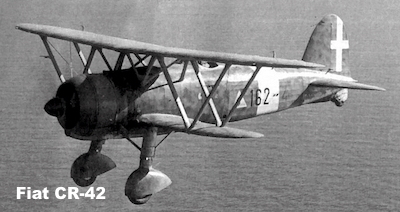
The difficulties they were faced with on the operation to Milan on the 14th February 1943 were of a very different order of magnitude. They had successfully bombed and were leaving the target area when a nightfighter attack started a fire in the fuselage and the port outer engine. In spite of suffering burns, Sgt. George Dove, occupying the mid upper turret, together with rear gunner Sgt. Airey, shot down the CR 42 (shown left). Although he was wounded, Sgt. Airey’s initial burst from the rear turret hit the nightfighter and set it ablaze. Sgt. Dove then administered the coup de grace as the Luftwaffe pilot turned away from his target (1).
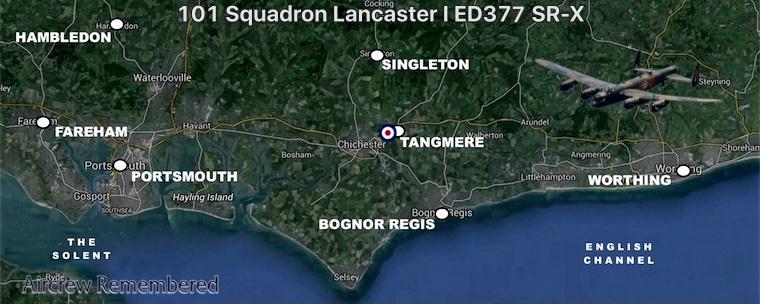
During the confusion the bomb aimer, P/O. Moffat, mistook an instruction from the pilot and left the aircraft. After a spell as a PoW in Italy, he spent the rest of the war in Stalag Luft 3, Sagan, Bavaria.
The order given by Sgt. Hazard was actually to prepare to bale out. At that moment, he was not aware that the rear gunner was trapped in the rear turret. When this became clear, the order was rescinded, but P/O. Moffatt had already left the aircraft.
In the effort to put the fire out, Sgt. Hazard had dived and levelled out at 800 ft. Having decided to fly the aircraft home, he was then faced with the task of regaining height in order to cross the Alps on three working engines and one which needed to be nursed.
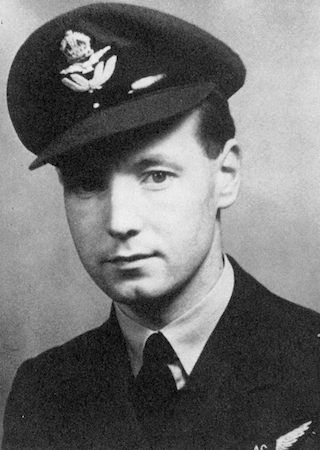
Left: Sgt. George Dove.
Meanwhile, the fire inside the fuselage was spreading. Initially confined to incendiaries which had hung up in the bomb bay, it began to spread through the fuselage, threatening to consume the mid upper turret. Sgt. Dove was already suffering from second-degree burns to his face and hands when he left his position. He then realised that Sgt. Airey was in trouble at the rear of the aircraft. To reach his comrade, George Dove had to make his way through the flames while machine gun bullets from the ammunition ducts were flying everywhere. After leaving his turret, the mid upper gunner was unable to communicate with the rest of the crew, and was working without oxygen.
He found Sgt. Airey in a bad way. Without the help of George Dove he would have found it extremely difficult to negotiate the huge hole in the floor of the Lancaster, which had been caused by the nightfighter. However, George Dove succeeded in releasing Sgt. Airey from the rear turret, and made him as comfortable as he could.
While the rest of the crew were fighting the fire, and at 800 ft, Sgt. Hazard took on the task of bringing the crippled Lancaster home. Assisted by P/O Gates, the pilot coaxed the Lancaster over the Alps, sometimes flying down Alpine valleys because he was unable to gain enough height while nursing the damaged engine. From time to time, P/O. Gates left the cockpit and made his way down the fuselage to help with the wounded rear gunner. This involved struggling around the hole in the floor.
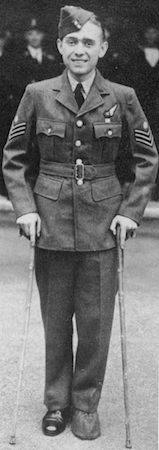
Navigator, Sgt. Williams, flight engineer, Sgt. Bain, and wireless operator, P/O. Gates, were also fully occupied. Williams navigated by dead reckoning and astro fixes for the five or six hour trip home. He also had to engage with the added problem of neutral Swiss air space. Sgt. Bain nursed the fuel system, and P/O. Gates, taking periodic rests from firefighting, completed a temporary repair to the aircraft wiring. This enabled him to restore communications. He also fitted in the duty of administering periodic shots of morphine to both gunners.
Right: Sgt. Leslie Airey.
Against all the odds, this crew brought their aircraft back to the UK, landing at RAF Tangmere.
It is noteworthy that the report from A.V. Roe Company on their trusty Lancaster stated: “It was the severest fire damage ever seen to one of our aircraft, and the Skipper has to be praised on his skill in getting it back”.
Apart from the CGM awarded to the pilot, George Dove, William Ernest Williams, James Fortune Bain and Leslie Airey also received the CGM. In the case of the pilot, the initial recommendation was for the VC, but this was overruled. Frederick William Gates received the DSO. Four CGM awards in one crew on one operation was an astounding achievement.
London Gazette 1943-03-23:
On the night of 14th February, 1943, Pilot Officer Gates, Flight Sergeant Dove and Sergeants Williams, Bain and Airey were members of the crew of an aircraft captained by Sergeant Hazard, which was detailed to attack Milan. Whilst over the target area, the aircraft was attacked by an enemy fighter from -close range. Its gunfire exploded some incendiary bombs which had failed to release and a fire quickly developed in the bomber. The fuselage became a mass of flames reaching through the mid-upper turret manned by Flight Sergeant Dove. Ammunition in the turret boxes and ducts commenced to explode in all directions. In the.face of an appalling situation, Flight Sergeant Dove coolly remained at his post. Although he was burned about the hands and face, he manned his guns with grim resolution, skill and accuracy. He delivered a devastating burst at the attacker, which had already been engaged and hit by the rear gunner and succeeded in destroying it. Disregarding the roaring flames, he then descended from his turret and went to the assistance of Sergeant Airey, the rear gunner, who had been wounded, and extricated him from the rear turret. The situation had become extremely critical and Sergeant Hazard ordered the crew to prepare to abandon aircraft. When informed that one of his comrades was helpless he decided, in spite of the grave risk entailed, to attempt a forced landing. Meanwhile, Pilot Officer Gates, assisted by Sergeants Williams and Bain bravely tackled the fire with extinguishers and succeeded in getting it under control. The aircraft was now down to 800 feet but, as the fire had subsided. Sergeant Hazard quickly decided to attempt to fly the badly damaged bomber home. He regained height and displaying fine airmanship crossed the Alps in safety, although i engine failed whilst so doing. On the remainder of the journey Pilot Officer Gates rendered valuable assistance to his captain and frequently ministered to his wounded comrade, Although this necessitated clambering over a hole sin the floor of the aircraft in darkness. Aided by the skilful navigation of Sergeant Williams and good work by Sergeant Bain, the flight engineer, Sergeant Hazard succeeded in flying the seriously damaged aircraft back to this Country. In circumstances of the greatest danger, this aircraft crew displayed-courage, fortitude and devotion, to duty in keeping with with the highest traditions of the Royal Air Force.
The postscript to this story is that three of the crew, Sgt. Hazard, Sgt. Bain and Sgt. Williams, died on the 20th March 1943 when Lancaster ED446 SR-N crashed during an air test. This was shortly before the London Gazette published the citation for Sgt. Hazard’s CGM. Sgt. Williams is buried in his home town of Llandudno. Sgt. Bain is buried in Cambuslang Cemetery, while the 22 year-old pilot is buried in Wolvercote Cemetery. He was from Oxford.
F/O. Frederick William Gates sadly died on the 5th May 1943. At 30 years of age he was well above the average age of aircrew in WWII. From Cheam, he was married to Ellen Gates and is buried in Sutton Cemetery. He was the wireless operator on Fl/Sgt. Hough’s 101 Squadron Lancaster which crashed in North Yorkshire while homeward bound from a raid on Dortmund which was described as ‘a quite awful night for 101 Squadron’ by Bill Chorley (2). Lancaster ED835 SR-T had sustained major flak damage.
(1) Combat Report filed by Sgt. George Dove 14th February 1943 (National Archives of Great Britain AIR/50/292/73)
(2) Chorley, W. R. Royal Air Force Bomber Command Losses of the Second World War. Volume 4. Aircraft and Crew Losses 1943. Midland Counties Publications 1996.

The Lost Gunner - Author Lyndon Pugh. Available from the publisher or via Lyndon - contact us in the first instance. Limited copies available from the Hours Bookshop in Powys, Wales.
Sgt Ronnie Pugh, my father’s younger brother, was killed during WWII while serving in 101 Squadron of RAF Bomber Command. He was the rear gunner in the crew of F/Sgt. Billy Banks RAAF.
101 Squadron Lancaster ED373 SR-K
This crew had been in action throughout the Battle of the Ruhr in the Spring and Summer of 1943. Their aircraft crashed off Zaandvoort in Holland, after an encounter with a Luftwaffe nightfighter, and six men died in the early hours of the 26th June 1943. One member of the crew, bomb aimer Geoff Brook, survived and served out the rest of the war in a German prison camp. The author was fortunate enough to talk to him in detail before his death
Addendum: (submitted by Jack Albrecht - see credits)
Sgt. Hazard, limited by a hydraulic failure and only 10 degrees of flaps, was able to pull off a textbook landing on the fighter strip at Tangmere. Sgt. Bain was so skilful with balancing fuel cocks that a mere fifteen gallons sloshed around the port inner tank on landing - essentially vapours for a petrol thirsty Lanc, scant minutes before a forced landing due to fuel starvation!
Unfortunately his story has a tragic ending. After a deserved special leave Sgt. Hazard returned to his squadron. On March 20th 1943 he was assigned to air test a brand new Lanc, ED446. His crew of ten in total, included Fl/Sgt. Bain and Sgt. Williams from his original crew. When pulling up from a low level pass at Hornsea beach the tail wheel struck a concrete pill-box on the beach. The result was catastrophic with the aircraft breaking up. The forward section struck the cliffs and exploded. The tail section cartwheeled onto the beach. There were no survivors.
Fl/Sgt. George Dove was not aboard and survived the war. On one occasion he was reprimanded by a ranking RAF officer for wearing his CGM ribbon incorrectly. Apparently the officer had mistaken the award for the highest gallantry as a mere campaign ribbon.
A most tragic end for these brave young souls. It is ironic that they rose to the monumental challenges of an operational mission only to succumb to the seductive hazard of low level flying, paid the ultimate price, destroying a factory fresh aircraft in the process.
The three vignettes of LL956, PB413 and ED377 exemplify the absolute unpredictability of the fate of aircrew and aircraft on ops with Bomber Command.
There were no guarantees. A battled hardened crew could get “the chop” just as swiftly as a rookie one on a gardening sortie. Similarly, a factory fresh Lanc could lift off into into the falling night never to return. Yet a battle thrashed kite would return on cue, begging for more. After repairs ED377 would return to the fray, first as SR-X and then as SR-Q, returning from eight tough German targets including Essen, Berlin (2), Hamburg, Stettin, Dortmund and Dusseldorf (2). Her luck ran out on a mining sortie on 27/28-6-43.
It is interesting to consider the decorations awarded following these three losses. For some reason the obvious courage of the crew of LL956 was overlooked. The leadership and bravery of the wireless operator of PB413 were rewarded with an immediate DSO. The pilot, who died from his injuries, was awarded the Legion of Honour medal two years posthumously by the government of France. The surviving crew members of ED377 (SR-X) were awarded five CGMs and a DSO. On review the circumstances of the events for PB413 and ED377 are very similar in the hazards encountered and the valour and crew cooperation displayed. Each crew managed to navigate their aircraft back to England. The crew of PB413 did so with an incapacitated Skipper! They were able to pull off a textbook off-airport forced landing without further injuries. Each returned missing a crew member due to inadvertent bale outs.
Most disturbing is the inequity of decorations awarded to these crews. With the exception of the Legion of Honour awarded to F/O Harold Hannah, the decorations were exclusively to members of the RAF or RAFVR. It is easy to comprehend the disappointment of the Hannah family due to the unrecognized sacrifice by their two sons.
References:
CD- A Tribute to Bomber Command by Joe Williams Rear Gunner. No 625 Squadron and Nic Lewis.
Track No 6 - Battle Order read by Joe was the catalyst for this submission. It describes the saga of ED377 and Sgt. George Dove.
Battle Order:
Lie In The Dark And Listen:
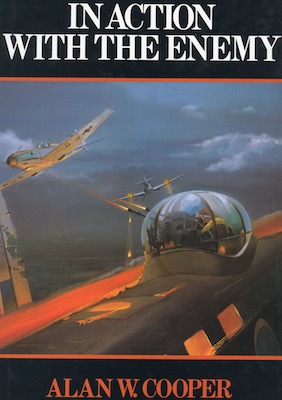
This submission is submitted to recognise these courageous young men for their contribution to the war effort and for comparison with other crews that made similar sacrifices but for some reason were not recognised or decorated for their valour. See these losses: LL956, PB413 and LM513 (pending).
Two members of 625 Squadron were awarded the Conspicuous Gallantry Medal: W/O Edward Sydney Ellis flying DV362 on the 2/3 December 1943 Berlin raid and Fl/Sgt. John Bettany, the wireless operator, of PB815 on the 23/24 February 1945 Pforzheim raid. ( 625 Squadron Loss 66). They will be documented in future submissions to Aircrew Remembered.
No Victoria Crosses were awarded to 625 Squadron aircrew.
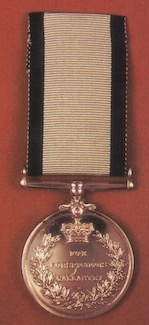
Burial details:
All crew survived this incident, later, others as described in this crew lost their lives in various incidents as described:
Sgt. Ivan Henry Hazard CGM. Wolvercote Cemetery. Sec.E.3. Grave 152. Son of Stanley Cecil John and Dora Hazard, of Oxford, England.
Sgt. James Fortune Bain CGM. Cambusalng Cemetery (Westburn) Grave 5059. Son of Alexander and Jeanie Curtis Bain, of Rutherglen, Scotland.
Sgt. William Ernest Williams CGM. Llandudno Cemetery (Great Orme’s Head). Of Llandudno, Wales. No further details - are you able to assist?
P/O. Frederick William Gates DSO. Sutton Cemetery. Sec. F. Grave 209. Son of Frederick Cuthbert and Elizabeth Louisa Gates, of Cheam, husband of Ellen Gates, of Cheam, Surrey, England.
Researched by Lyndon Pugh for Aircrew Remembered, February 2016. Additional details and photographs courtesy Jack Albrecht - March 2018. Also to David Langner, Nic Lewis, Alan Cooper. Other sources as quoted below.